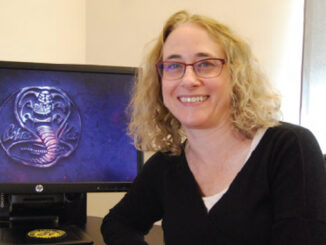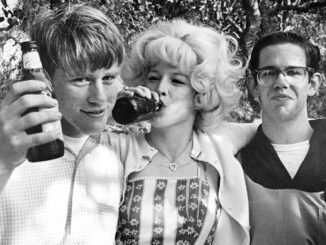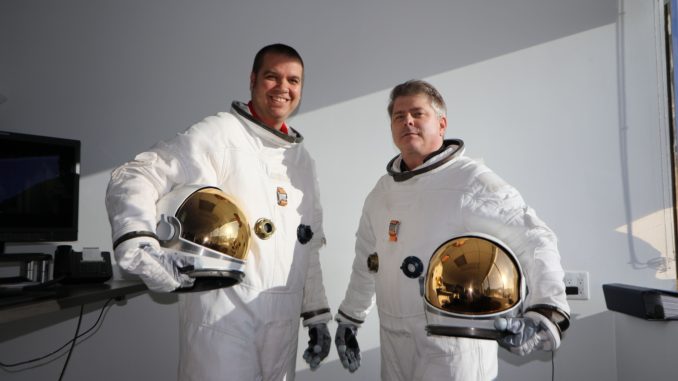
by A.J. Catoline
Sometimes in order to get found, we need to get lost. To go on a long journey of many miles, we need to first take that small step into ourselves, or — metaphorically speaking for editors — a journey into our own cutting room of the soul.
Brad Pitt goes on such a journey in “Ad Astra,” a film on a grand scale by director James Gray that delivers stunning visual effects sequences and also simple, intimate moments. Some scenes we are on a vast moonscape or a deep, dark lake on Mars. Then, the camera holds tight on the face of Pitt’s character — astronaut Roy McBride –– seeming lost deep in his mind as we hear his inner voice. He questions both the goal of his space mission and the meaning of his life. The only sound we hear is from inside his space helmet.
These are some of the editorial techniques used by film editors John Axelrad, ACE, and Lee Haugen, who continue their collaboration on “Ad Astra” after editing together on Gray’s last film “The Lost City of Z” (2016).

“’Ad Astra’ is an existential journey,” Axelrad said. “The further Roy McBride travels out into space, the deeper we go into his soul. It’s really a dive into the subconscious.”
Axelrad’s work with Gray stretches back more than a decade on his films “The Immigrant,” “Two Lovers” and “We Own the Night.” This editor knows well that his director loves to craft the film in the editing room and the entire post-production process.
“James is so hands-on, and he just loves editing,” said Axelrad. “He definitely milked every minute of his time in the cutting room. He is a meticulous filmmaker and very particular about the visual effects.”
“It was an extended directors cut,” Axelrad joked. Post-production was ongoing for about two years because the release of the film was twice delayed from early 2019, to the spring and now to a fall release. Mostly this was due to the complexity of the visual effects sequences that needed extra time to meet the director’s ambitious vision. But Gray used the extended schedule wisely to further craft the story.
“I don’t think a day goes by where James doesn’t come in first thing in the morning and say, ‘I got another idea,’” agreed Haugen, who said they had many options of Pitt’s performance to choose from.
“Brad’s performance was so subtle, but powerful,” said Haugen. “His little, tiny expressions would tell so much more about his internal dialogue. And having the voice-over helps the audience get even deeper into his thought process and into his soul. James wanted it to feel stream of consciousness.”
Pitt has said his portrayal of astronaut McBride — on a mission to find his famous astronaut-father played by Tommy Lee Jones, who has gone rogue somewhere in the galaxy — is inspired by his relationship with his own father. The performance is personal and it showed.
Haugen was inspired when he attended the first dialogue recording session with Pitt. “We had quite a few pages of lines for him to read. And he did it in one take, in one hour, without stopping,” said Haugen. “It was just so real, so methodical and so stream-of-conscious that we thought, ‘Wow, this is exactly the feeling we’re looking for in the voice-over.’”
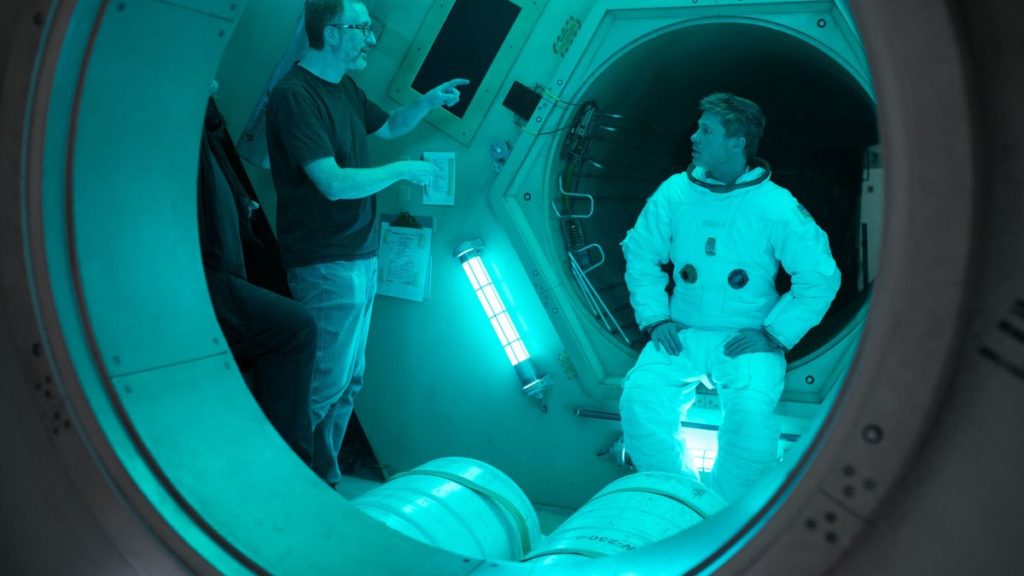
“To James’s credit, as he co-wrote the script with Ethan Gross, he knows the final rewrite is in the editing room,” said Axelrad. “And he is willing to change and keep working with the material that he shot. The sky is the limit to how the film can come together. James is not trying to mold the picture into the script he wrote, but rather create a new vision.”
Sound played a large role from early in the picture edit because “James is meticulous about sound. For him it’s the icing on the cake,” said Axelrad. “The hardest part about working with James is showing him a cut with a rough mix on the Avid. It takes me a while to polish the sound that he has come to expect. I love sound editing. Sometimes I feel like I’m a frustrated sound editor masquerading as a picture editor.”
Audiences might expect an action space movie to be loaded with sound effects, though there is a memorable scene in “Ad Astra” that nearly goes silent. When McBride reaches Neptune space, he goes space-walking through an asteroid field and the sound becomes eerily quiet, allowing us to appreciate the emptiness of space. Using silence as sound design is something that can make an audience sit up and notice. It can be revolutionary as Stanley Kubrick used in “2001: A Space Odyssey,” when all we hear is oxygen hissing through a space suit.
“This being a studio movie, there was an unease about having complete silence in the picture,” explains Axelrad. “Yet James wanted to be true to the science of space as best as he could. ‘2001: A Space Odyssey’ is one of my favorite movies of all time, but I purposely chose not to re-watch it before doing this project. I also chose not to re-watch ‘Apocalypse Now.’ I think none of us wanted to be influenced and we just wanted the material to speak to us.”
CineMontage sat down with the editors to discuss how the film came together, but also to ask questions about collaborating as a team. From the perspective of the cutting room, the story of “Ad Astra” is one of mentorship. Axelrad first hired Haugen as an Apprentice Editor in 2008 on “Two Lovers,” and they have continued a voyage as a picture editing team.
I encourage ideas and I encourage my assistants to edit. I’m not possessive like, “The credit has to be mine.” It’s not about ego, it’s about what’s going to make the best film. – John Axelrad, ACE
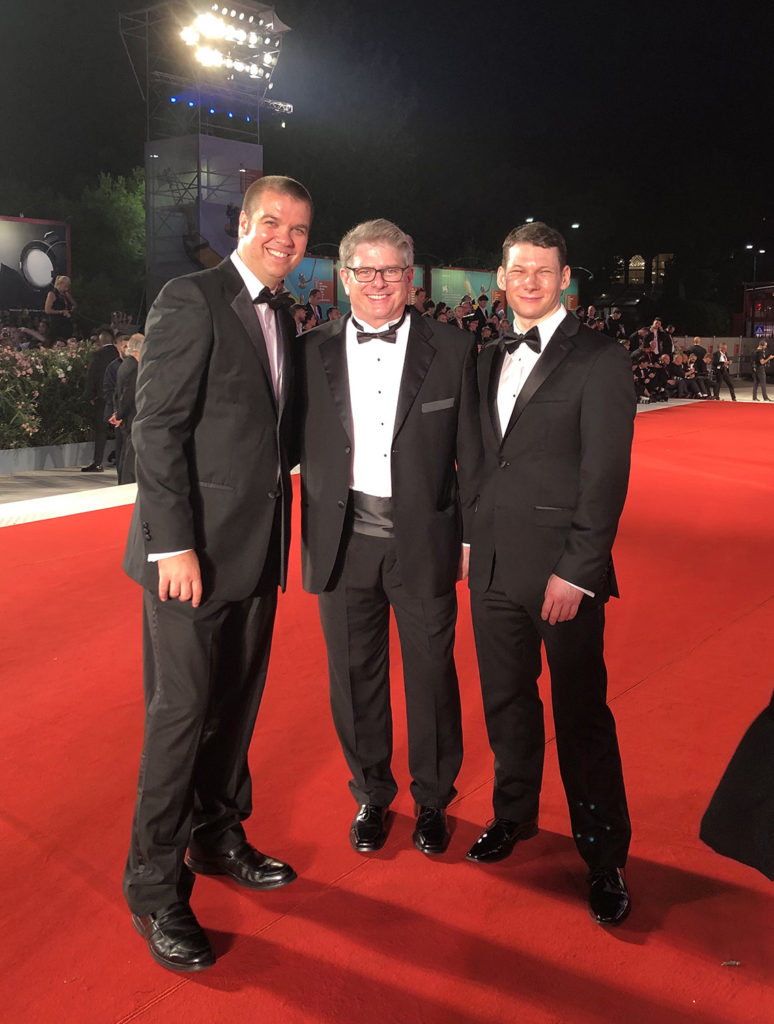
“’Two Lovers’ was such an amazing experience because I gained insight into the A-team of filmmaking that was John Axelrad and James Gray,” recalled Haugen. “And also John’s assistant editor was Tom Cross (‘Whiplash,’ ‘La La Land’). They were the most passionate, intense, and kind people. Being new to editing, they took me under their wings to teach me the ropes of the cutting room. John — being the great mentor he is — also gave me my first big opportunity. I could try and cut some scenes on my own and he would give feedback so I could hone my editing capabilities and style.”
“Lee would not be co-editing with me if he wasn’t a very excellent editor in his own right,” said Axelrad. “It’s not just because he worked with me once, I’m like ‘Okay, you’re next!’ Lee had to prove himself and he did. From the first time we worked together on ‘Two Lovers,’ I was impressed with his editing skill. As editors we hone our craft over time, and Lee and I got to the level where we were like, ‘Yeah, let’s edit together!’”
The “Ad Astra” picture editing crew is a triple-threat of mentorship. Like the Apollo 11 capsule that traveled to the moon 50 years ago with three cool astronauts, this cutting room made the journey with an Additional Editor. Scott Morris got his first job out of college as a production assistant on an independent film edited by Haugen.
Lee Haugen: Scott was the most ambitious production assistant I had ever met. And seeing that, I was hoping to pass along the same knowledge and mentorship as John had done for me.
Scott Morris: In school you can study film or the Avid, but only with experience can you learn the workflow and dynamics of a cutting room. Lee encouraged me to keep cutting and just do the work. I loved editing. I was always editing shorts or low budget features or anything I could do. Lee kind of showed me the path to just cut, cut, cut. Always be doing it.
John Axelrad: On “Lost City of Z,” I had to start the project later because I was finishing up “Krampus.” Lee and his assistant editor Scott went to Northern Ireland and Lee cut together the first editor’s assembly. It was my first time working with Scott, and I just all but fell in love with him. We then did “Papillon” together as a team. Scott was a huge contributor on both projects. On “Ad Astra” we were able to bump him up to an editor’s salary by following the union procedure. I think we developed such a collaborative workflow between the three of us. I encourage ideas and I encourage my assistants to edit. I’m not possessive like, “The credit has to be mine.” It’s not about ego, it’s about what’s going to make the best film.
And you brought in Hank Corwin as a consulting editor?
JA: Hank came in at the very end of the process. He worked a lot on the journey to Neptune sequence. Brad really wanted to get into the idea of someone losing their mind with isolation. I thought he added some really neat moments.
How do you all work together as an editorial team?
SM: We’ve created a team dynamic since we worked together on “Lost City of Z” and “Papillion.” We keep honing our workflow as our trust in each other grows. It’s like
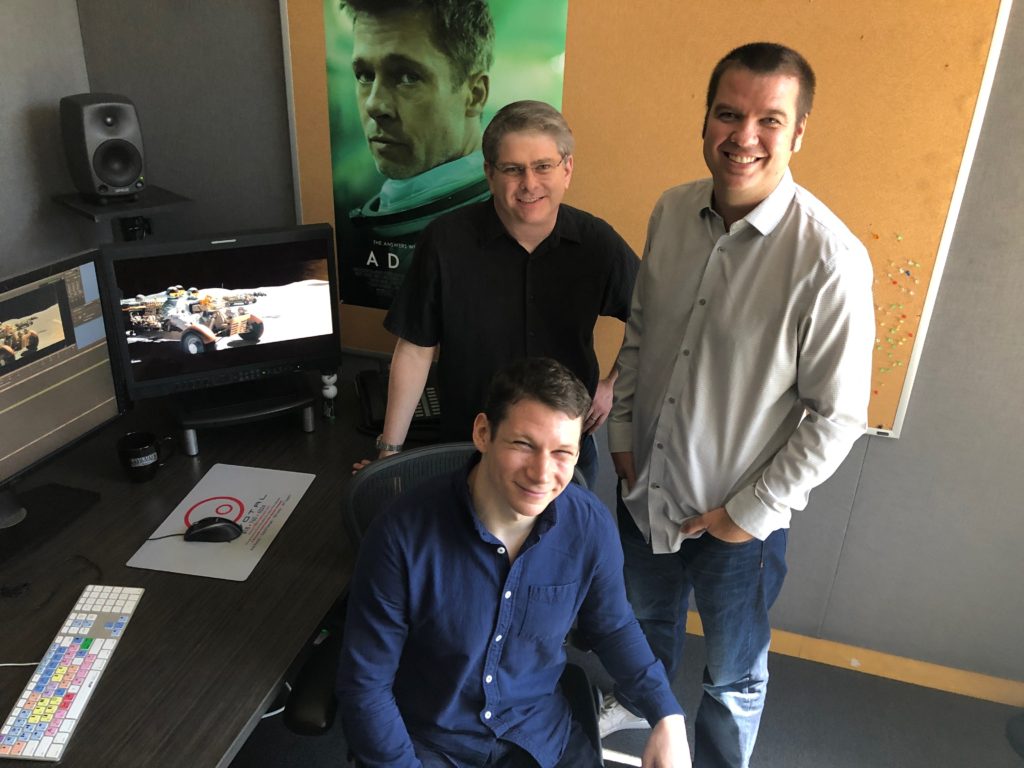
musical chairs, we all move together through the cutting rooms to screen and work ideas together.
LH: We work separately on a scene and then John and Scott will come in and we’ll watch and start collaborating together. And one of us will get an idea and want to go try it. It was a very efficient way of working to have a team to be able to explore our options and find these hidden gems that change the story and make it stronger.
JA: I think it benefits the film to have this kind of collaboration. We always say there are no bad ideas. Sometimes we’ll throw out an idea and maybe the director shoots it down, but in a creative environment you should be able to come up with outlandish ideas. Nothing pleases me more than to see my crew happy.
LH: We spend so many hours working together. We encourage an environment of having fun.
JA: Side story — every Friday we would have a pie-off in the cutting room. As Brad really appreciates a good apple pie, we would bring pies from various esteemed bakeries around Los Angeles.
What was the story where you all wore the space suits into the cutting room?
JA: That wasn’t just for fun but for a practical reason.
SM: We used the suits for proof of concept insert shots and the helmets to record sound from an astronaut’s point of view.

JA: Long before we got our re-recording mixer Gary Rydstrom to add his brilliant work, discussions about sound design began early in the picture stage. There was a big discussion on how much we hear and how much we don’t. And how can we hear that? And what sound would it be? In the lunar rover chase, there’s no sound on the moon. We wanted the perspective from what Brad would hear from feeling vibrations and impacts through his space suit.
JA: The lunar rover chase scene was shot in Death Valley near Dumont Dunes. The stunt men wore these suits on the moon buggies. They shot with infrared cameras to make the sky really dark, which helped with the visual effects. I’m on location in an air-conditioned trailer and — when I say air-conditioned — it’s still something like 91 degrees. But these poor guys are like out in 120 degree heat wearing 15-pound space suits.
LH: Truth be told, when we wore the helmets they still smelled like sweat from the shoot!
JA: That sequence evolved over a four-month period. We truly didn’t know if it was going to work until the end. It was very complex, so it was all story-boarded. But the stunt guys and the second unit director had to makes changes during shooting. It then became apparent that we needed some overhead shots of geography to heighten the tension. It was just too claustrophobic-feeling without it. We accomplished that with VFX. And then James brought the stunt guys back for insert shots on a soundstage. I wasn’t used to something coming together over such a prolonged period.
The soundscape was amazing, how did the post sound process come together?
SM: We mixed at the Skywalker Ranch for weeks with re-recording mixers Tom Johnson and Gary Rydstrom. It was an amazing collaboration and fun process hearing what they brought to it. Watching James working in the rapid pace of the stage with all the people and tools, like additional dialogue and sound effects, it’s like watching a conductor.
JA: I’ve mixed with James on all of his other films, and he’s like a kid — although a very discerning one — in a candy shop.
SM: The story is all about what’s going on in Roy McBride’s psyche. What he is feeling can be heightened by how it sounds. James would always be looking for ways to use sound design to get into Roy’s subconscious mind.
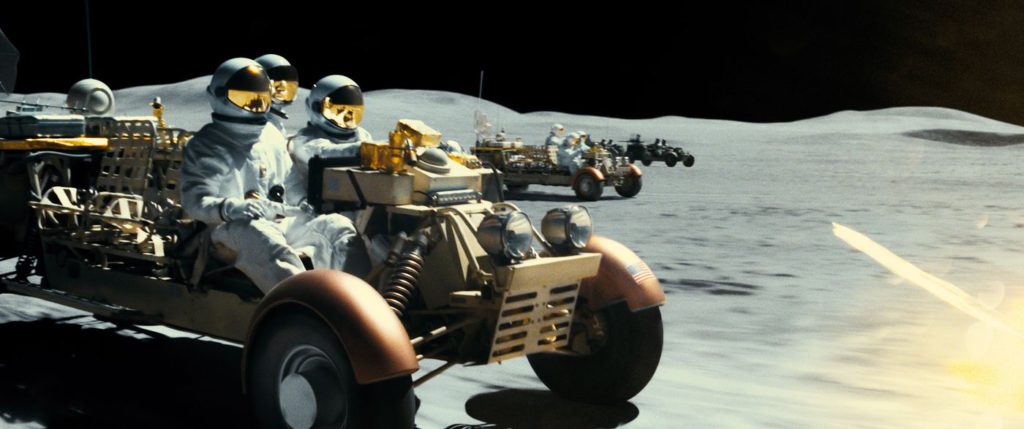
There is a scene in the film where Roy McBride is on his space ship watching an old film. A Dean Martin source cue plays that stands out from the rest of the film score. How was this song cue chosen?
LH: We wanted to go in the direction of using something old school, to juxtapose the future with the past. That was intentional.
JA: The film itself is an anachronism. Like our thoughts and our dreams, the future, the present, and the past are all kind of jumbled together. So if you see the film as a dive into the subconscious — where there could be a lot of old-school memorabilia even in space ships — the film feels like we are in a dream.
Talk about your current Assistant Editors. Does the mentorship continue?
JA: Since finishing “Ad Astra,” Lee and I are now editing separate projects. Lee has Jason F. Voss assisting him, and I have Jared Simon as my 1st Assistant Editor on this Lionsgate feature I’m cutting. It was my first time working with Jason and Jared on “Ad Astra,” and Lee and I want to continue to mentor and promote talented assistants. It’s Jared Simon’s first role as the lead assistant, and he is doing an absolutely wonderful job. He is getting the same exposure to the editing process as Scott Morris did, and Jared has had the opportunity to edit many scenes that I’ve given him feedback on. I love to see my team get excited to be a part of the creative process. Jared has contributed a lot of great ideas (both in picture and sound) to help elevate the quality of the edit.
When playing Roy McBride, Brad Pitt said he wanted to portray an astronaut who was tough and calm on the outside yet very vulnerable on the inside. Does an aspiring editor need to overcome feeling vulnerable to ask for help or mentorship? Do you feel that the position of Apprentice Editor is valuable?
LH: I think you do feel vulnerable when you put yourself out there and go outside your comfort zone. The most invaluable lesson for me being an Apprentice Editor from “Two Lovers” occurred once James Gray came in for the director’s cut. John asked me if I wanted to sit in during their edit. That simple offer provided me with the greatest access to see the interworking of an editor-director relationship. Not only did I get to see the technical side of John making edits, I heard the thought process between the two of them on why they made the edits. It was by far the most pivotal moment in my career.
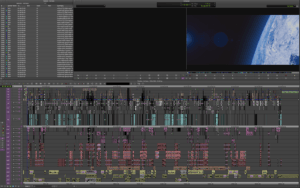
JA: I always fight to hire an apprentice editor and I do think it should be encouraged. I’ve had an apprentice editor on four films that I’ve done in the last 10 years. Unfortunately the Apprentice Editor position is kind of evaporating. But I want to keep it alive. I was an assistant for a lot of big editors back in the ’90s. Some editors were excellent mentors, and really took you under their wing. And some didn’t want you involved at all. It’s really a personality thing. On “Ad Astra” we started with Apprentice Editor Eddy Garcia. Eddy was absolutely fantastic and proved that not only would he be a great Assistant Editor, but he also really knew a lot about VFX. So when we saw an opening, we promoted him to become VFX assistant when our VFX Editor, Adam Avery, started working on the show. If someone shows skills beyond the role they are working in, we want to do our best to promote them.
SM: The Apprentice Editor serves a crucial role in ushering in the next generation of editors. I’m proud that the union has historically created this exciting position as a gateway to the cutting room and I hope the legacy continues.
JA: I believe the editor should fight for their crew. I’m a big proponent of moving people up in the end credits. Especially assistant editors because they get buried in the credit roll. I want my crew to be involved all the way down to the post-production assistant. I want them to feel part of the process, not just someone who goes out and gets lunch. In post, we are a team. It makes me so happy to see people I have worked with able to broaden their careers. So yes, I encourage mentorship.
LH: I’m grateful to be a graduate of the “School of Axelrad!” I’m sure other alumni of the school agree, because they have been successful in the industry. It’s a fun group that we have. We don’t have a Facebook group yet, but we should start one.


